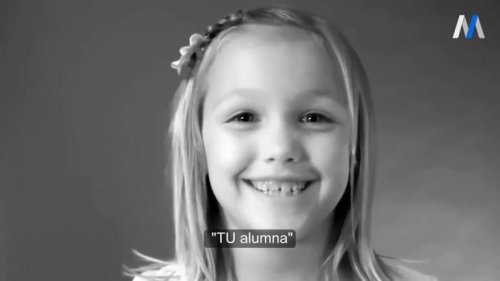"Dear Teacher": A Video to Help Understand Students with ADHD


Reviewed and approved by the psychologist Sergio De Dios González
Children diagnosed with Attention Deficit and Hyperactivity Disorder (ADHD) tend to behave differently in the classroom than how their teachers would like. This causes teachers to take measures that aren’t always best suited for the situation. If we could put ourselves in the child’s shoes, maybe we could understand how he sees the situation at school. How can we better understand students with ADHD?
It is easy to judge, get annoyed, and use solutions that are valid from our point of view. Nevertheless, we may just be creating more barriers to education for these children. Maybe they are paying attention, just not in a conventional or politically correct way. Maybe we think they don’t want to learn when in reality it is something that they truly enjoy. Students with ADHD have something to tell teachers (or parents, grandparents, or friends…) Are you willing to listen?
Self-regulation of emotions and the ADHD student.
A student with ADHD tends to have great difficulty controlling, regulating, and managing his emotions. That is why these behaviors seem to crop up in the worst moments and in the least appropriate ways. This lack of control causes the child with ADHD to express his emotions in an intense and uncontrolled manner. In the eyes of adults, this form of expression corresponds to immature behavior.
Immaturity, however, is not the cause in this case. Or at least not in the classical sense of the word. We are dealing with children. They are young, and therefore immature. Or maybe everyone is born mature? Using punishment to get a student with ADHD to change their inappropriate behavior is a useless exercise. Instead of pushing a child’s unintentional bad behavior, we must work on emotional management.

When a student with ADHD is punished so that she will control and repress her emotions, we can guess what kind of result we get: she will get defensive. If we don’t realize that, all we are doing is pointing out the student with ADHD, labeling her, and encouraging feelings of insecurity. None of this will benefit her in the least.
I am not less than “normal”, I am not worth less, I am not less capable. I simply work in a different way.
Do we really want children with this disorder to have low self-esteem? Is this what we are teaching in the classroom? We worry because they don’t learn in a conventional way. But maybe we should ask ourselves if we should stop trying to change them, and instead change the way we teach. We expect children to sit, be still, and be quiet while they listen to information they don’t understand. We want them to be adults and behave like adults, but we forget that they are only children.
How to understand students with ADHD
In the video, the children spell this out very clearly. Little ones with ADHD need to move and be given a free reign on their creativity. No child can sit still and be very quiet for a long time! Just because they are moving around doesn’t mean they are distracted, it’s simply their way of being able to learn. If they are still as statues, they won’t be able to.
It isn’t necessary to scold or punish a student for looking out the window or somewhere else. We’ve all done it on numerous occasions and it’s fine. After a minute or less, we re-focus our attention. It’s completely natural. Doling out some kind of punishment, like making the student miss recess, is terrible for a child with ADHD. They need physical activity. Children need to unplug just the same as we do. Do we really think that witholding rest, relaxation, and play will help them learn?

Children with ADHD need more support and help. If we don’t provide it, they won’t be able to do as we say because they won’t know how. Patience and calm are two essential qualities to be able to explain what they need and clear up any doubts that they have. Although the problem might be that what we’ve explained has a lot of information.
This is an important point. Many children disconnect because they receive a lot of information that they don’t understand. We might also find ourselves in the opposite situation, with children that get bored because they don’t have enough information. Finding the balance between these two extremes has a lot to do with the art of teaching. In terms of children with ADHD, we have to keep in mind that it’s especially difficult for them to work with a large amount of information at one time, especially if they receive the information in a non-dynamic way.
If there is one thing that children with this disorder require, it is acceptance of their way of learning, understanding, and comprehending. Their brain isn’t the same as everyone else’s, but that doesn’t mean that they aren’t as capable as other students. They just need more patience, more understanding, and less punishment.
Not understanding the origin of these disorders or what it’s like for those who live with them leads us to behave ignorantly with children who want to learn. We don’t understand them, so we can’t give them what they need. We shouldn’t saturate them with information, we shouldn’t bore them on purpose to try to get them to absorb information, and we shouldn’t punish them. If we treat them that way we are simply unloading our frustration onto them. Children with ADHD are intelligent and they want to learn. They are trying their hardest, they deserve that we do our best for them too.
Children diagnosed with Attention Deficit and Hyperactivity Disorder (ADHD) tend to behave differently in the classroom than how their teachers would like. This causes teachers to take measures that aren’t always best suited for the situation. If we could put ourselves in the child’s shoes, maybe we could understand how he sees the situation at school. How can we better understand students with ADHD?
It is easy to judge, get annoyed, and use solutions that are valid from our point of view. Nevertheless, we may just be creating more barriers to education for these children. Maybe they are paying attention, just not in a conventional or politically correct way. Maybe we think they don’t want to learn when in reality it is something that they truly enjoy. Students with ADHD have something to tell teachers (or parents, grandparents, or friends…) Are you willing to listen?
Self-regulation of emotions and the ADHD student.
A student with ADHD tends to have great difficulty controlling, regulating, and managing his emotions. That is why these behaviors seem to crop up in the worst moments and in the least appropriate ways. This lack of control causes the child with ADHD to express his emotions in an intense and uncontrolled manner. In the eyes of adults, this form of expression corresponds to immature behavior.
Immaturity, however, is not the cause in this case. Or at least not in the classical sense of the word. We are dealing with children. They are young, and therefore immature. Or maybe everyone is born mature? Using punishment to get a student with ADHD to change their inappropriate behavior is a useless exercise. Instead of pushing a child’s unintentional bad behavior, we must work on emotional management.

When a student with ADHD is punished so that she will control and repress her emotions, we can guess what kind of result we get: she will get defensive. If we don’t realize that, all we are doing is pointing out the student with ADHD, labeling her, and encouraging feelings of insecurity. None of this will benefit her in the least.
I am not less than “normal”, I am not worth less, I am not less capable. I simply work in a different way.
Do we really want children with this disorder to have low self-esteem? Is this what we are teaching in the classroom? We worry because they don’t learn in a conventional way. But maybe we should ask ourselves if we should stop trying to change them, and instead change the way we teach. We expect children to sit, be still, and be quiet while they listen to information they don’t understand. We want them to be adults and behave like adults, but we forget that they are only children.
How to understand students with ADHD
In the video, the children spell this out very clearly. Little ones with ADHD need to move and be given a free reign on their creativity. No child can sit still and be very quiet for a long time! Just because they are moving around doesn’t mean they are distracted, it’s simply their way of being able to learn. If they are still as statues, they won’t be able to.
It isn’t necessary to scold or punish a student for looking out the window or somewhere else. We’ve all done it on numerous occasions and it’s fine. After a minute or less, we re-focus our attention. It’s completely natural. Doling out some kind of punishment, like making the student miss recess, is terrible for a child with ADHD. They need physical activity. Children need to unplug just the same as we do. Do we really think that witholding rest, relaxation, and play will help them learn?

Children with ADHD need more support and help. If we don’t provide it, they won’t be able to do as we say because they won’t know how. Patience and calm are two essential qualities to be able to explain what they need and clear up any doubts that they have. Although the problem might be that what we’ve explained has a lot of information.
This is an important point. Many children disconnect because they receive a lot of information that they don’t understand. We might also find ourselves in the opposite situation, with children that get bored because they don’t have enough information. Finding the balance between these two extremes has a lot to do with the art of teaching. In terms of children with ADHD, we have to keep in mind that it’s especially difficult for them to work with a large amount of information at one time, especially if they receive the information in a non-dynamic way.
If there is one thing that children with this disorder require, it is acceptance of their way of learning, understanding, and comprehending. Their brain isn’t the same as everyone else’s, but that doesn’t mean that they aren’t as capable as other students. They just need more patience, more understanding, and less punishment.
Not understanding the origin of these disorders or what it’s like for those who live with them leads us to behave ignorantly with children who want to learn. We don’t understand them, so we can’t give them what they need. We shouldn’t saturate them with information, we shouldn’t bore them on purpose to try to get them to absorb information, and we shouldn’t punish them. If we treat them that way we are simply unloading our frustration onto them. Children with ADHD are intelligent and they want to learn. They are trying their hardest, they deserve that we do our best for them too.
This text is provided for informational purposes only and does not replace consultation with a professional. If in doubt, consult your specialist.







